|
 |
QUEENSLAND UNIVERSITY REGIMENT
ASSOCIATION Inc |
 |
| |
NEWSLETTER |
|
|
Volume 17 Number 4 |
November 2005 |
President's Report
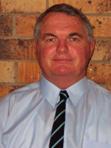
We are all saddened by
the passing of Brigadier John Springhall MBE OAM KStJ RFD ED PhD MVSc
MACVSc recently. Many of us who were privileged to serve in the
reserves with Brigadier John were indeed lucky. Personally I was
greatly influenced by him through his strong leadership and compassion
for his men. He will be sadly missed. As per requests by
the family the Association passed to St Johns Ambulance a donation in
lieu of flowers. Brigadier Springhall commanded QUR from 1962 to
1965 and served as the Honorary Colonel from 1980 to 1984. The
eulogy delivered by the current Honorary Colonel Major General John
Pearn is included in this newsletter.
The Annual General Meeting was again held at the United Service Club.
It was very well attended. It is pleasing to note that we are
steadily increasing in numbers each year. Paul Deighton, an ex
member of QUR who joined the RAAF, presented the after dinner speech.
Paul spoke about his time in IRAQ. Many guest speakers
previously have demonstrated that service in QUR had a strong
influence on their careers. Paul spoke about those skills he
used in his career. The previous management committee were
re-elected to carry on the duties for the 2005/2006 year. The
contact details for all members can be seen in this newsletter.
It is very pleasing to report that the number of ex members who are
contributing to the history project is increasing. We are
receiving photos, newspaper clippings and written memories. I
would encourage all who read this report to consider writing of their
time with QUR. It does not have to be a literary masterpiece but
all contributions help to fit more pieces into the history jig saw
puzzle.
Recently I visited the regiment and collected many of the items of
historical interest from storage. These items are currently
being catalogued and preserved. These items will be displayed
when we can get some furniture. You will recall that I made an
appeal to all to consider contributing towards the purchase of some
display cases. I suggested that members might band together and
make a single contribution, such as the doctors, dentists, the lawyers
etc. I again appeal to all to assist. Every contribution,
no matter how small will help. Ruth Kassulke has willingly
volunteered to act as the Association’s history officer and she will
be looking to receive your contributions.
A supply of the new ties and the woven gold coat badges have now
arrived. I am acting as the retail sales officer so please
contact me. With revenue from our membership fees reducing we
are working hard to raise finance through the small profit made on our
retail items. The woven gold coat badges are spectacular.
Even if you don’t intend wearing one on your coat (they are fixed to
the pocket with clips and therefore easily removable without damage to
the pocket) they make an excellent badge for a plaque. You can
order on line through the internet or contact me by phone or mail.
We have set the dates
for the Xmas 2005 functions and all functions in 2006. They can
be seen later in this newsletter. I would invite you all to
attend the Xmas function. It is only as couple of drinks and a
few nibbles after work on Friday 2 December 2005 at the Victory Hotel
in Brisbane. It is a great chance to “associate” with members of the
QURA.
I wish you all the best of the festive season.
Trevor Luttrell
*****************************
CO's Report
 Commanding
Officer’s Report to the Annual General Meeting of the Queensland
University Regiment Association Commanding
Officer’s Report to the Annual General Meeting of the Queensland
University Regiment Association
9 September 2005
QUR remains a very busy Unit in 2005. Posted strength is
currently 123 staff and 80 Staff Cadets and we are located at St
Lucia, Indooroopilly and Townsville.
Recent changes to the charter for the Unit from RMC-A have resulted in
a reduction of the number of courses run by the Regiment, but an
increase in the training liability picked up by QUR for each of the
courses we will continue to run. The Part Time First Appointment
Course for initial officer training is still our bread and butter
program and we have become the national specialists for key field
modules in that training. Our Staff Cadets and staff will travel
to other University Regiments for the conduct of other training in the
program suite. QUR is also responsible for some full time
soldiers under the Officer Tertiary Recruitment Scheme, some full time
soldiers studying for year 12, and a range of Officer of Cadet
courses.
We are very proud of the training program delivered by QUR and for the
third year our Staff Cadets have excelled in the capstone continuous
training at RMC. QUR graduates took out the top four of five
national prizes. Of course, we are hoping for another excellent
achievement standard for the next graduating class.
Aside from conducting high quality courses, some important events in
the year to date have been: the Back to Regiment Function in March;
Unit Parade on ANZAC Day with Toowong RSL; Band contribution to 1 JSU
Dawn Service and the City Parade for ANZAC Day; the Regimental Dinner
attended by Queensland’s Governor Ms Quentin Bryce, AC, in May; and,
Band Contribution to VP 60 in August.
Unit development projects have attracted a lot of time and effort in
the past few months. General maintenance, refurbishment, refurnishing
and reorganising has hit almost every corner of the St Lucia site. Our
next target is the appropriate organisation and display of Unit
historical items. We are working closely with the QURA to come up with
a plan that displays the materials to best effect for the
establishment of a sense of place for the unit and to educate the
Staff Cadets and staff about the historical significance of QUR, RURQ
and Gatton. As recently reported in the QURA newsletter our
intention is to place display cases in strategic places around the
unit and to gather historical materials from each of the component
units that have become QUR and establish a “RURQ” room, and an “OCTU”
room.
This year has seen the end of tenure for Major General Denis Luttrell,
AO RFD ED as Honorary Colonel and the installation of Major General
John Pearn as our new Honorary Colonel. This has been a
significant event for the Unit. Major General Dennis Luttrell has been
a wonderful role model and support for past CO’s and I know that he
will be sorely missed in the role. Major General Pearn AM RFD KStJ,
comes in as an energetic and committed Honorary Colonel who I’m sure
will continue the excellent precedent set.
Since the last AGM there have been some painful losses to the Unit
family. Colonel Garry Chandler, RFD a past CO late last year and
just last week Shane Slipais a young officer of the Regiment in the
80’s have both died seemingly well before their time. Although I
didn’t know Shane personally I have found his mark on several things
around the unit in the past few days and know that he has made an
indelible impression. Colonel Garry Chandler, who I count as a
personal friend, supported me every step of the way to assuming
Command with QUR, and I can certainly see why he was so insistent.
This is a fantastically enjoyable job for me, and a privilege, for
which I am grateful.
Thank you.
Nan Bahr
Lieutenant Colonel
Commanding Officer
Queensland University Regiment
*****************************
QURA 2005 AGM held
on 9 September
Over 30 members attended the Annual General Meeting held at
United Service Club,
Wickham Terrace, Brisbane on the evening of
Friday 9 September 2005. Members were treated to a sumptuous
meal and a very interesting talk from our speaker, Flight
Lieutenant Paul Deighton.
Paul served in QUR as a Lance-Corporal to about 1991. Some
time later, he resigned from his job as a Primary School
Teacher and joined the RAAF full time as an Education Officer.
His presentation highlighted how he found skills learnt at QUR
were extremely useful in later life.
Some photos of his time in IRAQ appear below.
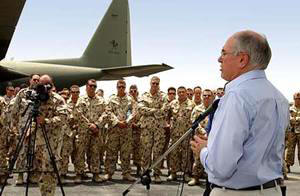 |
Prime Minister with C130
Contingent |
|
Accommodation in IRAQ |
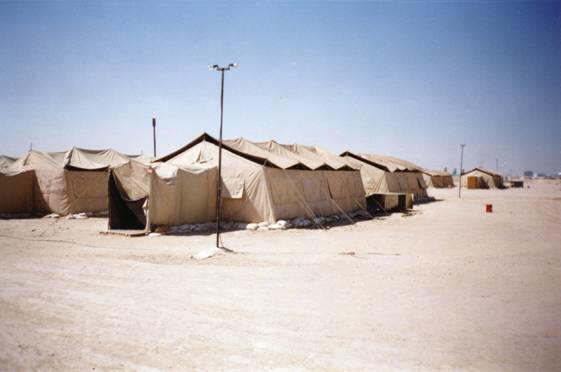 |
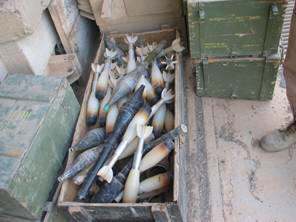 |
Ammo Dump |
|
C130H at Sunset |
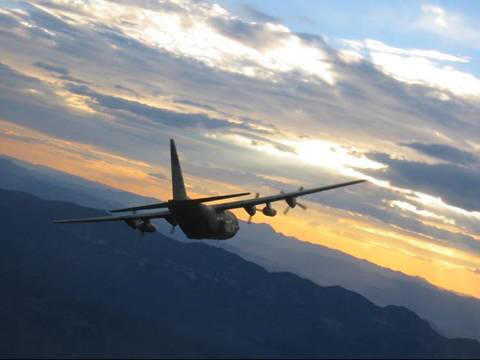 |
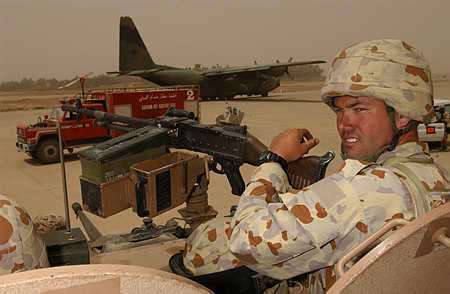 |
C130H at Baghdad International
Airport |
|
Crew on Deck of C130H |
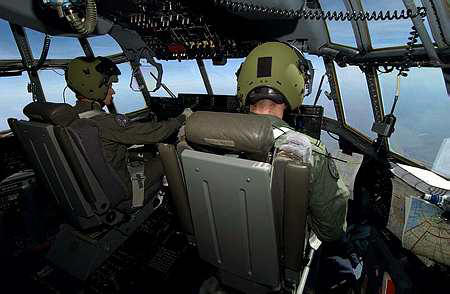 |
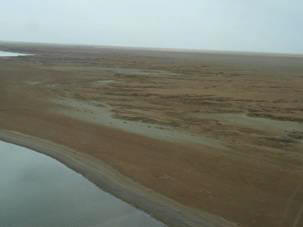 |
IRAQI DESERT |
|
Loading C130H with Med Supplies |
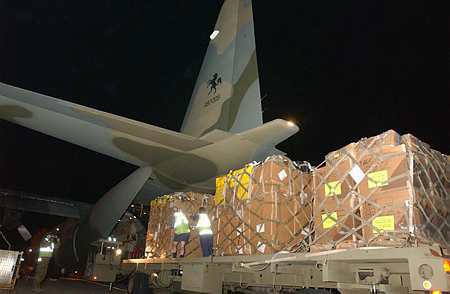 |
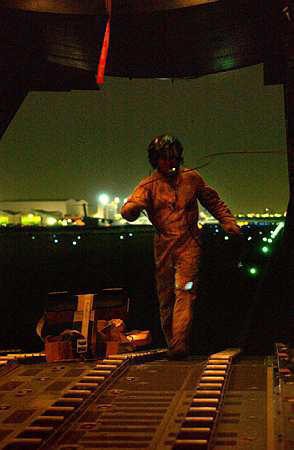 |
Loadmaster Organising Med
Supplies for Baghdad |
|
Med Supplies at Baghdad |
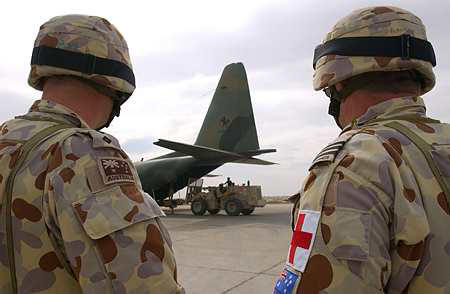 |
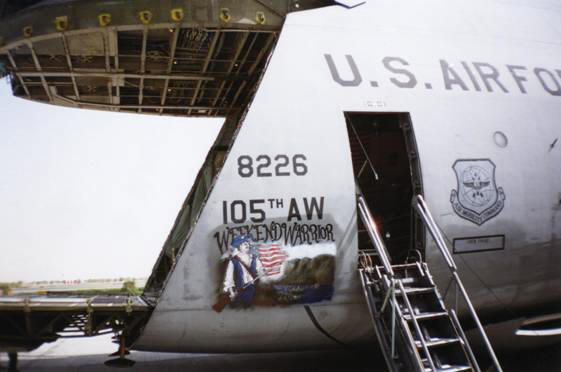 |
National Guard C5 at Kuwait |
*****************************
FUNCTIONS IN 2005/20066
-
Christmas Function
2 December 2005 (Victory Hotel)
-
Back to the Regiment 10
March 2006
-
Anzac Day 25 April 2006
-
Regimental Dinner
6 May 2006 (Invitation from QUR)
-
AGM
15 September 2006 - (To be confirmed)
-
Christmas Function
1 December 2005 (To be confirmed)
*****************************
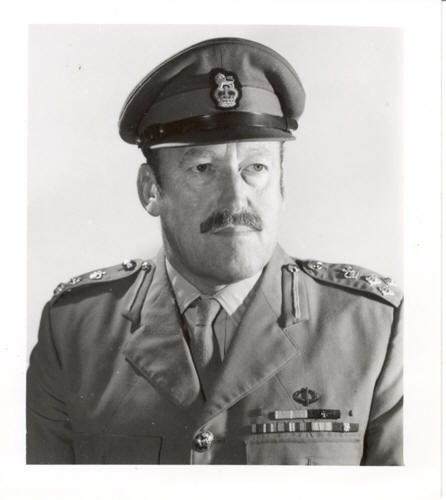
A Tribute Eulogy
A Commemoration of the Life
of
Brigadier John Anthony Springhall
MBE OAM KStJ RFD ED PhD MVSc MACVSc
1922-2005
On the Occasion of his Funeral Service
St John’s Cathedral
Brisbane
Friday 7th October, 2005
Delivered by
Major General John Pearn AM RFD
October 2005
John Anthony Springhall has served both as a servant and a leader
in three distinct and disparate professions. He has been a
close friend and confidant, a mentor and a counsellor to many
hundreds who have been privileged to know him, to have worked with
him and to have been taught by him. He has been one who
brought to every aspect of his personal and professional life the
personal qualities which made the name of John Springhall
synonymous with the highest ideals of community service and of
complete integrity.
At his Funeral Service in St John’s Cathedral in Brisbane, several
hundred have gathered together as a witness and expression of this
close personal friendship - for indeed few have been blessed with
more good personal friends than this exceptional man. Many have
come together in collective tribute, symbolising the most
important public themes of volunteer community service which
characterised John Springhall’s life.
The academic gowns of the University of Queensland are a witness
of our esteem of his primary profession of veterinary science and
animal husbandry, in a field to which he contributed so much to
the developing world. The distinctive bottle green berets of
our colleagues of the Queensland Commando Association are an
affirmation of his courage and service as a frontline commando
during the Second World War. The military uniforms of the
Australian Defence Force are a tribute to his leadership not only
in the Royal Australian Infantry but in those other proud Arms and
Service Regiments which he commanded with such distinction.
The uniforms of St John Ambulance Australia and the mantles of the
Order of St John, together with the emblems of the Sovereign
Military Order of St John and those of the Most Excellent Order of
the British Empire, and of the Order of Australia (including the
OBE Association which he helped establish) are also witness to his
creativity and service. His loyal role in so many
associations, including his proactive membership of both the
Queensland Club and the United Service Club, has contributed to
both those bodies to which he brought his inimitable stamp of
pride in shared heritage and the preservation of collegiate ties.
As a boy, John Springhall grew up in Bellevue Hill in Sydney and
attended The Scots College. He was an enthusiastic participatory
sportsman, and a senior oarsman at the School. He attended Scots
as a day boy, successfully completing his matriculation year in
1940.
A Veterinary
Surgeon
Many knew Dr John Springhall primarily as a veterinary surgeon.
After his schooling at The Scots College in Bellevue Hill in
Sydney, he matriculated to the University of Sydney and graduated
with his veterinary degree therefrom in 1949. He was appointed a
Lecturer in Veterinary Surgery at the University of Sydney in
1950. His 32 years as a practising vet encompassed a special blend
of academia, of private practice and of his work within the
commercial industry of animal husbandry. He established in his own
veterinary practice in Orange in Western New South Wales and it
was there that he met and married Janette Hood, who with their
loving and extended family have been the datum of the extensive
group of friends, professional colleagues and associates who have
come together to pay their last respects.
For four years, John worked as the Senior Veterinary Officer
firstly with the Development Division of Drug Houses of Australia
and then as the Manager and Research Director of Crago Stock
Feeds, based in Sydney. Following his work in both private
practice as a veterinary surgeon and his work in the commercial
aspects of veterinary science, he brought his practical and
experienced background of clinical veterinary practice and
commercial employment to his work as an academic at the University
of Queensland.
He served as a Lecturer and Senior Lecturer in Veterinary Science
and Animal Husbandry at the University of Queensland for 23 years
until his retirement in 1982. It was during this period that he
successfully completed his Master of Veterinary Science Degree;
and subsequently in 1972 was awarded one of the first Doctor of
Philosophy Degrees within the Faculty of Veterinary Science at
this University. John’s special interests were in the development
of food stocks to promote animal husbandry in the developing
world. Over a period of 15 years he was a leader in the
development of self-sustaining food stocks for poultry and pig
production in the nations of the south-west Pacific. He had been a
Guest Speaker at the 1962 World Poultry Science Convention in
Sydney, a forum which sparked his interest in the importance of
research and practical teaching in the establishment of commercial
poultry, pig and fish farms, initially in the (then) Territory of
Papua New Guinea; and later in the Cook Islands and in American
Samoa.
His research and the training of local farmers’ co-operatives and
collective groups involved many visits to Papua New Guinea,
particularly to the Torricelli Mountains in the Sepik District and
to Lae and Finchafen in the Morobe District; and in the Eastern
Highlands based in Goroka. This important work helped establish
the principles and practice of self-sustainability in small
communities in several nations of the western Pacific. He was a
consultant to many of the Missions in the Territory of Papua New
Guinea and his advice and counsel led to the establishment of many
self-sustaining systems of pig, poultry and freshwater fish
production on those Mission Stations. This in turn led, in no
small measure, to their independence and profitability. Such in
turn served as models for a number of the civilian co-operative
communities throughout the Territory, an influence which persisted
well beyond 1976 when Papua New Guinea became independent and our
nearest Sovereign neighbour.
In 1976 he conducted training courses in Tropical Pig Production
and Porcine Nutrition in the Cook Islands for the South Pacific
Commission. Again, in 1982, as a representative of the University
of Queensland, he worked for the South Pacific Commission in the
development of self-sustaining nutrition, from local sources, for
both pig and poultry production. From 1976 to 1978, in addition to
his teaching and research duties based in Brisbane at the
University of Queensland, he was appointed Director of Studies for
the Australian Development Assistance Agency, within the
Department of External and Foreign Affairs, providing lectures on
tropical veterinary nutrition to students from Africa, Sri Lanka,
Hong Kong, Malaysia, Korea, the Philippines and another six
nations of the Pacific region. Besides his technical knowledge and
practical experience, his personal qualities of leadership led to
his being elected President of the Queensland Branch of the World
Poultry Science Association; and for six years he was the
representative of the Queensland Egg Marketing Board on various
government bodies responsible for overseeing poultry research and
egg supply. In this context he was elected Chairman of the
Queensland Chicken Meat Council, in an era which saw the rapid
change and huge increase in chicken consumption on Australian
tables.
In a letter that John wrote to me, following our meeting together
in Goroka in Papua New Guinea where we both worked, in 1969, he
said and I quote:
“My research in tropical nutrition of pigs, poultry and fresh
water fish has been directed towards assisting the development of
intensive industries in the Pacific Nations. In this context I
have endeavoured to identify and use local materials, otherwise
unsuitable for human consumption, for the establishment of
sustainable poultry, pig, fish and other livestock nutrition, thus
helping to eliminate the competition for often scarce food
materials between man and domestic livestock; and to decrease the
dependency of importation of prepared animal feeds into developing
nations”.
In all, he published some 24 research papers on this crucial work
of animal husbandry. These topics ranged from such erudite
subjects as the use of “Ferrous sulphate as a detoxifying agent
for mimosine for chickens”, through to a major paper (co-authored
with Dr I.S. Burgess) entitled “Feeding Pigs in New Guinea”, to a
significant paper on the husbandry of catfish and other freshwater
fish in a paper entitled “Management and Production of Freshwater
Fish” published in the Australian Veterinary Journal in 1972. He
worked on the exploitation of otherwise noxious weeds and on the
recycling of what would otherwise have been waste products as
alternative feeds for poultry. In this context he published in
1974 another significant paper entitled “Grapeseed and Water
Hyacinth as alternative feed ingredients for poultry”.
His most proud work was a small book on horseshoeing, which was
published through three editions. It is believed by veterinary
colleagues “still to be the most authoritative work on
horseshoeing in the English language”.
A University
Academic
One estimates that more than 40,000 graduating students of the
University of Queensland, knew John Springhall as the University
Marshall, through his role within the University Department of
Ceremonies and Protocol. His meticulous personality and attention
to detail, his military training, and his innate sense of the
importance of occasion, made him the perfect choice as the
University Marshall within the University of Queensland. In this
role, from 1963 until 1975 and again from 1979 until 1982, he was
responsible for the preparation and conduct of all University
Ceremonials ? not only of all Graduation Ceremonies, but at the
interface between the University of Queensland and its Vice Regal,
National and International visitors; and its hosting and
representations to politicians, diplomats and visiting senior
dignitaries. He brought to this role a feeling of certainty and
security that everything would always be conducted “just right and
with due decorum”.
Everyone who knew Dr Springhall understood that he held, as a
fundamental belief, the importance of maintaining priceless
traditions which might otherwise thoughtlessly be cast aside and
thus lost forever. I remember his telling me on one occasion that
however many hundreds, even thousands that there might be at a
graduation ceremony, each individual graduate remembered and
identified personally with the traditions that were being
followed; and that such applied to them as an individual and had
meaning for them as an individual, irrespective of the crowds
which were present.
A Commando
Private Springhall enlisted in the Second A.I.F. in 1941. He had
been an outstanding schoolboy sportsman, and a keen participant as
a rugby and tennis player, an athlete and rower and as a keen
skier. It was with this background, and with his personality
features of forthrightness, duty and courage, that he was to wear
for four years on active service, the unique and proud bottle
green beret of that elite brand of brothers, the Australian
Commando.
He served as a commando for four years in the 2/6 Independent
Company at Balikpapan and elsewhere in Borneo “behind the lines”.
Very occasionally he would describe some of his experiences, in
those times, operating perhaps in the most dangerous environment
in which in which any soldier can fight. With his colleagues, he
was active in demolition work, the cutting of supply lines, the
destroying of enemy communications and in numerous ambushes.
In his retirement, Brigadier Springhall served in more recent
times for more than 10 years on the Committee of Management of the
Queensland Commando Association, together with colleagues who had
also served in the Independent Companies, with the Coastwatchers
and with those survivors who had served in the “Z Force” special
units. In 2003, he was elected Life Patron of the Queensland
Commando Association, a role to which he brought his forthright
and vigorous personality and a total loyalty to his old comrades
in arms.
His persona, as a fit and vigorous former commando, extended to
many cognate themes that characterise that unique and proud group
of soldiers. As a trained commando diver, John continued his
interest in scuba diving, and was elected as the Medical Officer
for the University of Queensland Underwater Club. He once wrote to
me that “If you know Boyle’s and Charles’ Laws and CPR, nothing
else matters!” In the great tradition of “derring-do”, exemplified
by Australian Commandos, he also was a skilled
Tiger Moth pilot. In his proud wearing of his green commando
beret, with its Coastwatchers’ and “Z Force” badge entwined, he
exemplified that spirit of adventure which not only fought behind
the lines but knew well both the undersea world and the domain of
the sky.
A Military
Leader
After the conclusion of the Second World War, John Springhall
continued his voluntary service in the Citizen Military Forces. He
was decorated with a military MBE in 1956. On promotion to
Lieutenant Colonel he was appointed as the Commanding Officer of
the Queensland University Regiment and served for a triennium from
1962. In that era the Regiment trained every Sunday, and as the
momentum for Australia’s deployment to Vietnam grew (from 1964),
the Regiment grew in size to become eventually that of a full
infantry battalion, albeit modified in its structure and training
for its specialised Officer Training role.
After various senior staff postings he was promoted to Brigadier
and appointed as Commander of 7 Task Force, based at Kelvin Grove
in Brisbane. In this role he was also the Assistant Commander of
the First Division; and as such was the Senior Army Reserve
Officer in Queensland for the triennium from 1975. All of us who
were privileged to serve under him remember his meticulous
attention to detail and his fine leadership skills. He brought to
that senior command position in the Australian Defence Force not
only the experience and reputation of a former commando, and not
only his service as a most successful Commanding Officer of our
University Regiment, but the confidence and respect of one who had
achieved at highest levels in his civilian professional career.
His role as a senior academic, his active service during the
Second World War as a commando, and his manifest success in
commanding the Army Reserve Brigade here in Brisbane in the
difficult post-Vietnam era, led to his appointment as Honorary
Colonel of the Queensland University Regiment in 1980. He served
with distinction in that role for five years; and thereafter has
been one of our most esteemed “Old Soldiers of the Regiment”. His
consummate professionalism, his bonhomie, his loyalty and his
preservation of tradition has made him a role model for many.
St John Ambulance Australia
One of Brigadier Springhall’s most proud roles was that of his
service within St John Ambulance Australia. It was to St John that
he brought a special enthusiasm and vigour, binding the drills and
skills, volunteerism and leadership from his military career, to
this esteemed civilian charitable body.
In the spirit of the Good Samaritan, but with his unique persona
of up-front muscular Christianity, he has been a dominant presence
in St John, both in Queensland and Nationally, for the past 35
years.
He was appointed District Superintendent in Queensland in 1969;
and led St John’s uniformed Branch, then called the St John
Ambulance Brigade, for a triennium from 1978. During his period as
Commissioner to the St John Ambulance Brigade, he established the
St John Recruiting Unit, the Direct Entry Officers Programme and
the After-Hours Oxygen Delivery Service. This latter, a
co-operative enterprise with Commonwealth Industrial Gases based
at South Brisbane, provided an emergency “after-hours” oxygen
delivery service for sufferers of breathing disorders throughout
the Brisbane region. This innovation also contributed some
important resources for the volunteer and teaching programmes of
St John in Queensland.
One of his most important legacies was his foundation of the
Community Care Branch of St John in Australia, in Queensland. He
served as its first Chairman. In addition to this charitable work,
he was the Ceremonies Officer for St John in Queensland (and for a
period also Nationally) for some 20 years. In this capacity, he
maintained the proud traditions of St John, with its ethos of
voluntary service to the community in the context of acute illness
and injury. The Order of St John - the secular Royal Order of
Chivalry, which was established by Queen Victoria - occupied a
special place in the last three decades of his life. He was
decorated by Her Majesty as a Knight within this Royal Order in
1984; and he remained a fierce guardian of its traditions until
his death.
Standards and Service
Each of us brings to this Tribute, our personal and individual
knowledge of a person of outstanding and exemplary service. Each
of us has our own memories of Dr John Springhall. His students,
many now themselves leaders in the professions of veterinary
science and animal husbandry in Australia and internationally,
remember his special skills as a University teacher. They recall
the “extra and personal” time that he spent with individual
students, his personal encouragement and counsel, and the humour
with which he coloured his lectures and tutorials. The former
soldiers whom he commanded, at least eight of whom have gone on to
Brigadier or General rank, remember him as a forthright leader in
the tradition of the “soldier’s soldier”. All remember his life of
exceptional and public volunteer and charitable service, that our
society might be enriched.
What all of us remember is that in matters of principle, of
tradition and of integrity, Brigadier John Springhall was always
there, unflinchingly “up-front”. He has always been one of the
first to draw a “line in the sand” if we strayed from tradition;
and yet so often was the first to give praise and to encourage a
junior or a colleague and say “well done”.
At his Tribute Service of farewell, we have come together as a
collective witness to a unique Australian. We extend our sympathy
to his wife, Mrs Janette Springhall and to his brother, the
retired Sydney Surgeon, Dr Bill Springhall; and especially to his
children - to Jane and Alan Nash and their sons; to George and Kim
Springhall and their children; and to Katrina and Bruce Ferguson
and their sons. We extend our closest thoughts and our sympathy to
their husband, their brother, their father and grandfather. In
addition to the love and affection held in their hearts and
memories, John Springhall’s record is in the annals of the many
bodies in which he served and to which he gave such exemplary
service.
Esteem to his memory
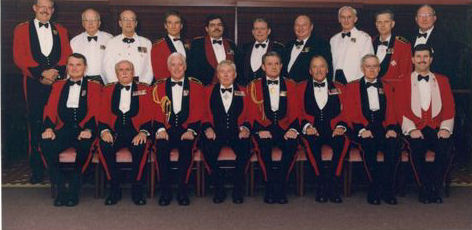 |
Front Row Left to Right
Brigadier Trevor Luttrell, Brigadier Tom Parslow, Major
General Steve Golding, Major General The Hon Jack Kelly,
Major General Dennis Luttrell, Brigadier John Springhall,
Brigadier Sam Harrison, Lieutenant Colonel Garry Chandler
Back Row Left to Right
Colonel Rod Hamilton, Colonel Pat Shanahan, Colonel
John Pearn, Colonel John Taske, Colonel Vlas Efstathis,
Colonel George Kearney, Colonel Gary McLeod, Colonel Peter
Rule, Colonel Peter Nicol, Colonel The Hon John Greenwood
Photo taken 1 July 1994, (Ranks
and titles as of the date of the picture)
|
*****************************
HISTORICAL DISPLAY CABINET APPEAL
As stated in the previous newsletter, the Commanding Officer QUR wishes to purchase cabinets to
safely and securely display items of history that are in trust
to the Association. The items will not be restricted to QUR
but will also include OCTU and QAC Training Unit/RURQ.
QURA has been actively collecting items of historical value. Now let us display them.
Recently the CO was delighted to receive two display cases
from the University of Queensland. The executive would
like to express our gratitude to Mary Lyons, Acting University
Librarian, University of Queensland for her work in assisting us with
these cases.
We are still looking to acquire a couple more so I continue to
appeal to you for donations towards the setting up of the
displays.
You can help in three ways:
All donors will be acknowledged by a sign/plaque placed inside in the
cabinet.
QURA MEMBERS ARE HARDLY EVER
ASKED TO HELP THE UNIT.
NOW IS YOUR CHANCE TO MAKE A REAL DIFFERENCE TO THE SAFE AND SECURE
PRESERVATION OF HISTORY.
HELP US SHOW THE UNIT MEMBERS WHY WE ARE PROUD TO BE MEMBERS OF QURA.
OUR COLLECTIVE SUPPORT SHOULD BE ABLE TO PROVIDE THE CABINETS.
Please send all offers of money or assistance to
Trevor Luttrell
Mail : PO Box 1045 Sunnybank Hills Q 4109
Phone: 0437 442 964
EMAIL:
trevor.luttrell@qed.qld.gov.au
*****************************
QUR Association 2005 Christmas Drinks
The 2005 Christmas Drinks for the QUR Association will be held at
the Victory Hotel,
Cnr Edward and Charlotte Sts, Brisbane on the evening of
Friday 2 December 2005 starting at 1730
hours. The Association has
reserved a section at the right front of the beer garden.
Due to limited resources , the executive has
decided to charge a fee of $10.00 per person to help defray some
of the costs of the evening. To reduce the admin overheads,
we'll collect the money on the night.
Attendance Reply Form – RSVP 28
Nov
05
EMAIL to Peter Morton at
peteramorton@bigpond.com
Name: ________________________________________________________________
-
I will be attending the
Association’s Annual Christmas Party to be held at the
Victory Hotel, Edward St, Brisbane on the evening of
Friday 2 Dec 2005 starting at 1730 hours.
-
I regret that I am unable
to attend. Please tender my apology.
*****************************
NEWSLETTER
Following a decision of the Executive, anyone
requiring a printed copy of the newsletter will now have to contribute $2.50
per year towards the postage
costs of the newsletter.
If you wish to receive this newsletter
electronically,
please email the Membership Registrar
(Peter Morton) at
peteramorton@bigpond.com.
To continue to receive the newsletter by post, please forward your
cheque to:-
The Treasurer
QURA Association Inc
24 Walcott St
St Lucia, 4067
For those members with internet banking, payments may be made
direct to the QURA Bank Account.
Details are BSB 064 129, Account 0090 4500, Account Name QUR
Association Inc
Please ensure
your name is supplied in the payment details.
Please note that the posted newsletter is a condensed version of the
edition that appears on the QURA website (www.qura.bigpondhosting.com).
Due to size limitations, some articles and photos may be removed
to enable the posted version to be sent at normal letter rates.
The QURA website to has the following contents:
*****************************
HISTORY
We intend continuing the collection of any pieces of history. We encourage members to take the time to write of their time in the Regiment. Either send it in hard copy of email it to any
Executive member.
Don’t worry about the formatting – just produce the words. We
will format it for the history collection.
*****************************
In the last newsletter, we presented
some of the emails from BJ Price re his trip visiting WW1
Battlefields.
The rest of BJ's emails are included for your appreciation:-
World Battlefield Tour - May 2005
(Contd)
Sitrep 4: Where Jacka Stood His Ground
From the heights of the Nek it was just
a 50m gentle stroll to Walker's Ridge past rows and rows of slowly
decaying support trenches. The self same trenches from whence our
blokes had gathered to launch that fatal charge where their only
gain was to put forever beyond doubt the quality of their mettle.
And so did they join the ranks of the immortals.
Walker's ridge was part of the right flank behind the Nek that
gave a commanding view right from this portion of the Second Ridge
southwards to Russel's Top and the Sphinx and Northwards to Suvla.
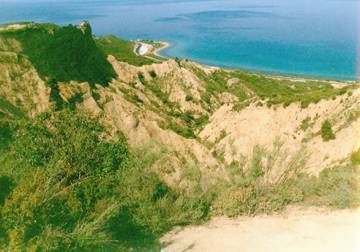
View from Walker’s Ridge
Probably
the most awe inspiring single natural feature in all of
ANZAC is the Sphinx, jutting out towards the beach like a
crumbling sand coloured bayonet. The sheer
impossibility of the terrain is plainly seen from this
cliff face, because up on Walker's Ridge…. one slip and
you'd be dead. We swung around Walker's and up onto Russel's Top which is
actually on the back of the Sphinx and from their you
could see back up the ridge and across to Monash Valley
topped by the legendary Quinn's Post.
It was said that Diggers would pause at the bottom of Monash and
look up the Quinn’s as a young child might at a haunted
house. The terrifying din of the constant close quarter
battle rarely relented day or night with the trenches
separated by only 20 odd feet. If we ever lost Quinn’s we would have
lost ANZAC and thus was it so fiercely and dearly
contested. In a similar way the whole line of Posts along
the 'front' were of extreme strategic import. Steel's,
Pope's and Courtney's are legendary names that we visited that cool clear
morning. We saw the trenches there of both sides, now just
a jumble of zig zagging depressions and amongst it was
still visible the entrance of a Turkish tunnel.
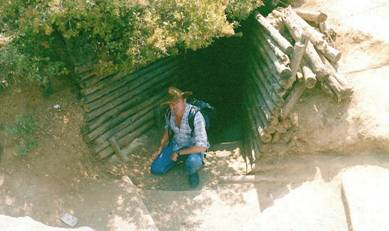
Turkish Tunnel opposite Quinn’s
Post
"I managed
to get the buggers Sir".
A typically laconic use of the vernacular to describe his cool
headed action at Courtney's Post on the night of May 18\19.
After reading so much over the years about the Digger whom CEW
Bean described as "Australia's finest fighting soldier" finally
here we stood.
The cool sea breeze began to pick up and wheeze
through the pines; everywhere the song of nightingales reinforced
the incongruity of Gallipoli. How could a place where such horror
unfolded be so completely beautiful. I could feel the tears begin
to well up, I choked them back and stood their silently and
whispered my respects to those who once endured that part of the
line. They too heard the nightingales sing and would remark on the
irony.
Courtney’s Post, now a neatly clipped lawn and a simple white
marble monument to mark the spot where Australias' first Victoria
Cross of WW1 was won by one of Anzac’s greats, our Bert Jacka.
On that fateful night in May when the Turks massed to push the
Anzacs back into the sea, Courtney's Post was overrun and occupied
by the Turks.
Not for long though it turned out.
Jacka retook it by charging over the top and straight in amongst
the Turks.
He shot two, bayoneted five and sent the rest running for their
lives.
Such fearless, determined action would mark his long and
illustrious war service in the 1st AIF that saw him finish with
the VC, MC and bar. According to Bean he should have received the
VC thrice but, well our Bert had a way of pissing off his
'superiors'....like all good Diggers.
God bless Bert, lest we forget cobber.
More to follow.
BJ
=================================================================
Sitrep 5 : The Pine
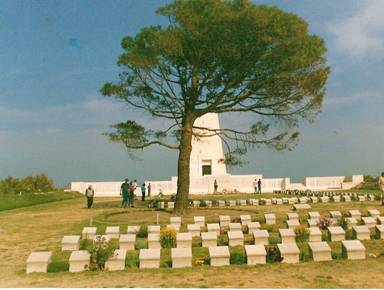
Lone Pine Cemetery
"It was no
easy thing to see which way they had come, so thick was
the ground sown with their dead and dying".
So did Lionel Baylebridge describe the terrible sight at
Lone Pine when the Aussies were loosed from the trenches
that had so long confined them and the August Offensive
was in full swing. We paid a
hellishly dear price for the feint that turned into a full
scale attack; some 2000+ dead and the most VC's ever won
for an Australian action....seven.
But not all the VC's in the world was worth the loss of
the least of one of our boys.
We walked to Lone Pine, and stood there in the shadow of
that imposing, solemn Australian monument juxtaposed with
that solitary pine tree and boys it wasn't an easy thing
to see which way they had come.
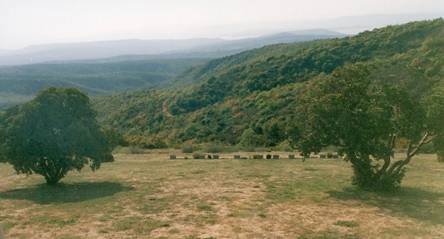
The 'way they had come'.
So many young blokes gone forever.
The killer for me was wandering through the cemetery and reading
the epitaphs to those fine brave lads........
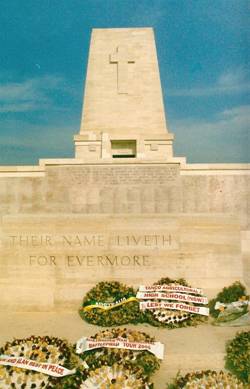
Lone Pine Memorial
We lingered a while, shed a few more
private tears and then somewhat reluctantly left them to their
eternal vigil and headed down off the Second Ridge straight
through the guts of ANZAC, past the lonely 4th Bn Cemetery, all
trim and clean....and sad.
We followed a faint goat track at its rear through
the scrub along the ridge of Braund's Hill and
traced our way, immersed in the ANZAC
terrain, between Monash and Shrapnel Gully. As we
walked unperturbed by the hell endured here by our
blokes again I must make mention of the serene,
evocative beauty of the battlefield. If
the desire took you, a man could walk not twenty
paces and collect a posy of some dozen or more
different blooms. Each one a study in nature's
magnificence, collectively a dazzlingly bunch of
floral beauty. A cuckoo chimed and as the gentle
sea breeze started to pick up it pushed the
patchwork foliage in those gullies like waves of
texture change. The whole place shimmered and the
heady scent of crushed thyme from our rugged
progress through the scrub added to the sensory
experience.
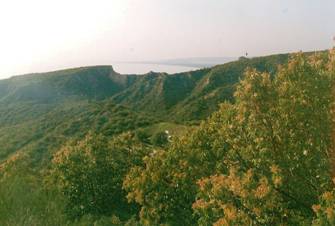
The Guts of ANZAC
You almost felt as if you had to pinch yourself
lest you got too bloody introspective but the
hairs were standing up on the back of my neck and
I seemed to have a perpetual lump in my throat. I
mean here we were bush bashing through the back
blocks of ANZAC where blokes like Billy Sing 'the
murderer' plied his trade as an untested sniper,
where the selfless Simmo and his donkey Murphy
trudged, where our men lived fought and died hell
West and crooked. It was both sobering and
intoxicating.
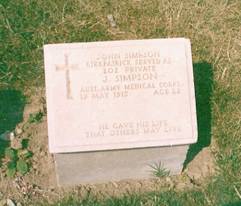
Simmo’s Grave
Of course to have walked that self same ridge
during the Campaign would have been both foolish
and most likely fatal but today amongst the
indentations of eroded dugouts we walked with
impunity, our only wounds were those of the thorny
camel bush which again in this place of contrast
was ablaze with bright yellow flowers.
As we winded our way ever lower down those slopes
we could see the Shrapnel Gully Cemetery down
below us, another immaculate lawn of verdant green
set neatly with row upon row of military
gravestones and in it's midst a huge flowering
tree stood and shed it's petals which gathered in
drifts of spent pink against the graves.
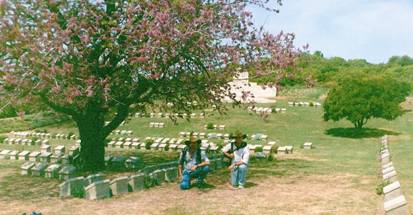
Shrapnel Gully
Cemetery
We stopped here for lunch, not saying much, just
lying back where our boys lay, taking in the
scenery trying to make it indelible. After a short
break we followed another small track off from the
Cemetery and climbed a steep track up to Russell's
Top which looks directly over ANZAC Cove and out
over the Aegean.
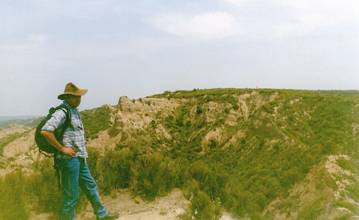
View Nor-east from
Plugge’s Plateau
I
was glad to see that from this high vantage all
signs of the roadworks were invisible, again I was
struck with how small the cove was, probably about
650 metres of shore where so much of significance
to Australia took place 90 years ago. We
took a few snaps and then headed down to the Cove
proper where Sparty did a Birdy and went for a
swim in the clear chilly waters. A took a few
snaps of him waving his slouchie as he swam
imitating General Birdwoods' much publicised
skinny-dip all those years ago. The media are
still tarts.
We paused to souvenir a few pretty pebbles from
that sacred beachhead and then said our goodbyes.
I won’t ever return. It was my Diggers' pilgrimage
and I have fulfilled that deeply personal oath.
God bless you men of ANZAC.
We are your sons, we honour you and we will never
forget your sacrifice.
BJ out.
===================================================================
Sitrep 6: The Western Front
I now know why our Diggers were so enamoured of
France when they first arrived there in the Spring
of 1916. Nearly ninety years on the French
Countryside has lost none of its enchantment. It
is the most beautiful place I have ever seen. The
most beautiful scenery in Oz can't hold a candle
to it. I'll go even further. The French were the
most hospitable, genuinely nice people you could
ever hope to meet, and their sheilas......boy our
dearth of barge arsed birds do not compare well
I'll give you the drum. I think maybe only 5% of
the population were seriously overweight and
everyone, bar us, dresses as if they off to a
Ball. In a nutshell, stylish, beautiful friendly
people in a Country so aesthetically gorgeous it
just bowls you. So bang goes all the stereotypes
about the French and France I ever held. I was
ill-informed and just plain wrong.
We picked up out flash brand new Citroen C4 (and
yes it went off like a bomb) in Paris and I
somewhat apprehensively took the wheel whilst
Sparty played navigator. Good Gawd...an Officer
with a map!! It was one hell of a freaky thing
going around corners and roundabouts the wrong
way, heading up streets the wrong way and having
the gear stick on the right but somehow we got to
Villiers Bretonneux without mishap.
I might mention that the slow lane on the highway
was 130km/per hour and we sat on 150km. The roads
were exceptional and the drivers the most
courteous you could ever imagine. Three lanes and
the slow lane is where the trucks are required to
travel. Drivers who overtake only stay in the
overtaking lane for the shortest time required to
complete the manoeuvre and then they pop back into
the middle lane. Consequently the traffic flows
like quicksilver and I don't think they know the
meaning of road rage. Struth but we could learn a
few things from this mob. Too many to mention in
fact here.
Anyway, it was mid afternoon and the sexton was
trimming the expansive lawn at the Australian
Cemetery when we arrived.
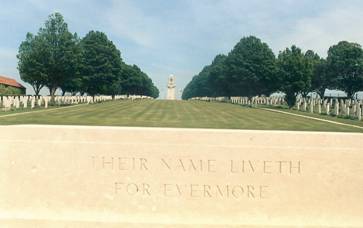
Villiers Brettoneaux
Cemetery
Again being on our own we had the place to
ourselves. No huge mob of noisy idjits being
shepherded around to disturb the poignancy. Just the drone of the mower and the larks singing
like they were fit to burst under clear blue skies
and with the breeze stiffening the flags.
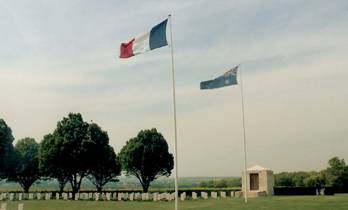
Age Shall Not Weary
Them
Probably the largest of the Western Front Aussie
Memorials Villiers Bretonneux was an extraordinary
experience. Just to stand there at the entrance
and look down the avenues of graves to the huge
ramparted memorial
wall with the Australian and French Flags flying
proudly side by side just ripped your guts out. You could just feel the emotion sweep over you. I
was powerless to fight that bloody lump in the
throat again and so we each
just wandered about alone trying to keep our tears
hidden. Could have done with some rain that day.
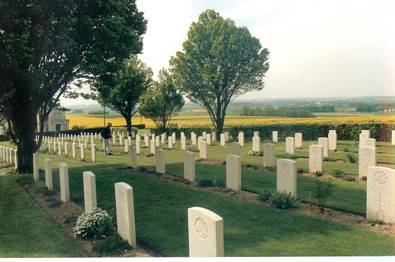
Rest in Peace
Cobbers
I guess we spent a good hour wandering that sacred
high ground, torturing ourselves by reading those
epitaphs.
Those heartfelt words just nail you through the
heart. The very first gravestone I stopped at was
a Digger from 51st Battalion so it was tough from
the word go.
We finished up at the register and signed our
names and again paused to look out of that
magnificent countryside. It's mainly agricultural
land as green as green with various pastures and
crops contrasting beautifully.
Set here and there in that rich rolling land are
copses of trees, an acre here, there ten, all
foreign to me but simply breathtaking. So
our men now rest in heaven.
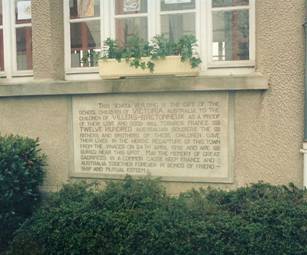
Ecole (School)
Victoria
We headed down to the
School Victoria and visited the museum attached to
it. It had a terrific collection of Australian War
memorabilia and from
the window you could see that famous banner in
their schoolyard.
NEVER FORGET AUSTRALIA.
To see it there so
prominent so bold and so proud was simply wonderful
and a fitting end to an extraordinarily emotional
day.
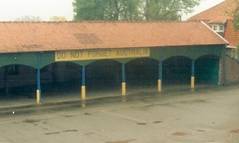
‘Do Not Forget
Australia’
BJ out.
===================================================================
Sitrep 7: Menin Gate at Midnight
For the first couple of days in Northern France we
based ourselves at Amiens which is a large
bustling city and well placed for day trips in the
mighty C4 Citroen to many of the battlefields
synonymous with our First World War Diggers.
"No battlefield has been more densely sown with
the Australian blood than Pozieres" so wrote CEW
Bean of that "ash heap upon ash heap", that place
where Jacka undertook "the single most audacious
act in the history of the AIF" and yet was denied
a bar to his VC.
Pozieres, where the sustained
cannon fire was considered the worst of any First
World War battlefield, where it rolled like the
Devil's timpani, his own hell's bells.
The morning we visited Pozieres, the weather had
turned bleak. There was a light misty rain falling
and the wind factor made a bloke wished he'd
packed a pair of gloves. The old town is not much
more than a main street with a few shops
surrounded by rolling agricultural land.... and a
pub..... Tommy's Inn, ironically with Australian
flags adorning the shopfront.
That was good enough
for us and as we stepped into its warm interior
we were greeted by a wall to wall display of WW1
memorabilia with the Aussies well and truly
over-represented...for a Pommy pub that is!
But better than that was what lay out the back. An
old trench system had been carefully excavated and
painstakingly reconstructed with an amazing degree
of detail. It was without doubt the best and most
realistic display we saw anywhere. The attention
to detail was mind boggling.
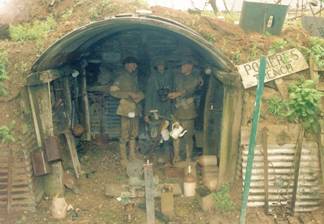
Pozieres Trench
Reconstruction
We kept stopping and saying "What the hell is
that?" I videotaped the system in it's entirety
from one end to the other. That afternoon we also visited Mouquet Farm (Moo
Cow Farm our boys called it) which is still a
working diary farm. It has a plaque set outside
with a few lonely looking grave stones and an
overview of the costly battles fought here by men
such as Harry Murray VC, our most decorated WW1
soldier. We
visited Hamel and trod the heights above the
famous village where General John Monash rewrote
the Pam on WW1 Battlefield Tactics on that red
letter day on July 4 1918. A beautiful curved
black tiled monument, embraces the heights there,
replete with exquisite reliefs of Monash and his
men and the actions that day that brought the end
of the war so tangibly closer.
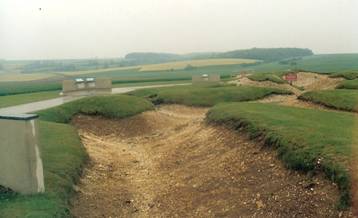
Hamel Trenches
There was no one there but Sparty and myself. No
noisy mobs spilling from tour buses, not even a groundsman, just us and our blokes. The whole area
was fenced off due to renovations but with no one
there to stop us in we went and trod the trenches
proper. I collected a small piece of rock from
Hamel to give to my old Digger mate John Farrell,
whose Lieutenant Colonel Grandfather won the DSO
there and whose citation reads “for the capture
of the village of Hamel". Now that's some
accolade.
From Hamel we drove down to the beautiful old
village Albert and as the clouds began to break
and the sun began to shine in patches, from a
great distance we could see her; the golden statue
of the Virgin Mary with child high atop the Albert
Cathedral. The famous statue which had hung at a
precarious angle due to shell fire during the war
and whose demise it was said would foretell the
loss of the war. Well the statue did not fall and
after years of pain we had our victory and today
she stands restored in all her majesty, unbowed
and gloriously visible for miles.
Ypres or Wipers as the Australians called
it was our next base camp. Here in Belgium were
fought battles such as Passchendale, Polygon Wood,
Menin , Messines, Hooge Crater and Armentieres. And here perhaps most famously of all in that
ancient city lies the Tomb of the Unknown Soldier;
the Menin Gate.
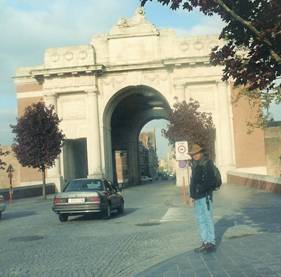
Menin Gate Ypres Belgium
Every evening at 8 o'clock, which is still bright
daylight in Springtime, the Flemish buglers in
full military regalia perform the Last Post in
chorus under the arches of that most imposing
monument and at every performance there is a crowd
of several hundred there to pay their respects. It
is a most inspiring sight and a spine tingling
event.
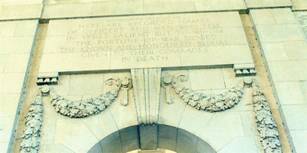
Menin Gate
Inscription
Ypres is also famous for the myriad of beers
brewed there. Virtually every cafe has its own
personal compliment of boutique brews. Damn shame. So on our last evening we decided to venture out
with a few bottles of beer into the chill night
air and visit the Menin gate at midnight. An oil
painting by Will Dyson with that same title
depicts the multitudinous ranks of ghostly
soldiers from horizon to horizon parading at
midnight before the Menin Gate. And so we headed
there and had a quiet ale with some of the
11000 Diggers who have no known grave but are
remembered here still.
Only the echoes of our footfalls and the
occasional passing vehicle punctuated our quiet
talk with those men, our young and not so young
who gave of their very lives so that our Country
and its' people could live and prosper.
We
will never forget them and their sacrifice. Lest
we forget.
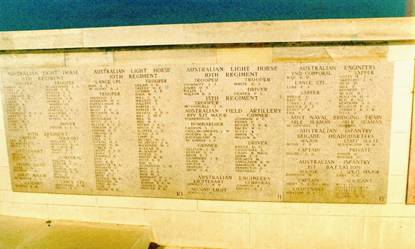
Lest we Forget
It
was an incredible experience our world trip and
this last night on the Western Front, at Menin
Gate was truly a highlight.
BJ
out
Thanks BJ Price for allowing us to share in
your wonderful experience
*****************************
If you pay your membership fees on a year by year basis payment is
now due
for 2006.
For those members with internet access, please
check the members page to ensure that your membership is
current.
For those members receiving this newsletter by post, a code showing your membership status is printed on the address label..
The codes are:
-
SMEMB - Special Member (no fees)
-
LMEMB - Life Member (no fees)
-
PUOM - Paid Up Ordinary member (no fees but can transfer to 10 year membership for $50)
-
NEW - New member (no membership fees received as yet)
-
2005 – 201? membership fees paid to year indicated
-
199? - 2004 membership fees due for 2005
Annual dues are $10 and a 10 year paid-up membership can be had for $70.
Postage of newsletter $2.50 per year
Cheques should be forwarded to:
The Treasurer
QUR Association
24 Walcott Street,
St Lucia
4067
For those members with internet banking, payments may be made
direct to the QURA Bank Account.
Details are BSB 064 129, Account 0090 4500, Account Name QUR
Association Inc
Please ensure
your name is supplied in the payment details.
*****************************

EMAIL ADDRESSES
The Executive Committee encourages all members to provide an email
address to allow quick and easy communication of important
notifications and reminders of upcoming events.
By moving to electronic notifications and access to our website for
newsletters, it is hoped to substantially defray our administration
costs. Producing the newsletter in an electronic form we can provide colour photographs
and can, in fact, include more pictures and articles.
We will still maintain a postal service for those members without email accounts
but an extra charge of $2.50 per annum will be required to assist in
the postage and handling costs.
For members wishing to provide a new email address, please send an email to Peter Morton at
peteramorton@bigpond.com
so he can ensure your address is
received and entered onto our contact list.
*****************************

HISTORY OF QUR
Have you
considered purchasing a copy of the History of QUR
magnificently complied and edited by Paul Smith?
It
contains 128 pages of stories, photographs and has a coloured badged cover.
COST : $15 per
copy.
What about a CD containing over 100 images of the history of the Regiment.
COST : $10 per
copy.
Why not treat yourself to a copy or buy copies for your friends. These are
collectors items so don’t miss out.
How to purchase copies:
Ring
Trevor Luttrell
0437 442 964
Email
trevor.luttrell@qed.qld.gov.au
Send your payment to:
The Treasurer, QUR Association, 24 Walcott Street, St Lucia Q 4067.
For those members with internet banking, payments may be made
direct to the QURA Bank Account.
Details are BSB 064 129, Account 0090 4500, Account Name QUR
Association Inc
Please ensure
your name is supplied in the payment details.
*****************************
Association Office Bearers
|